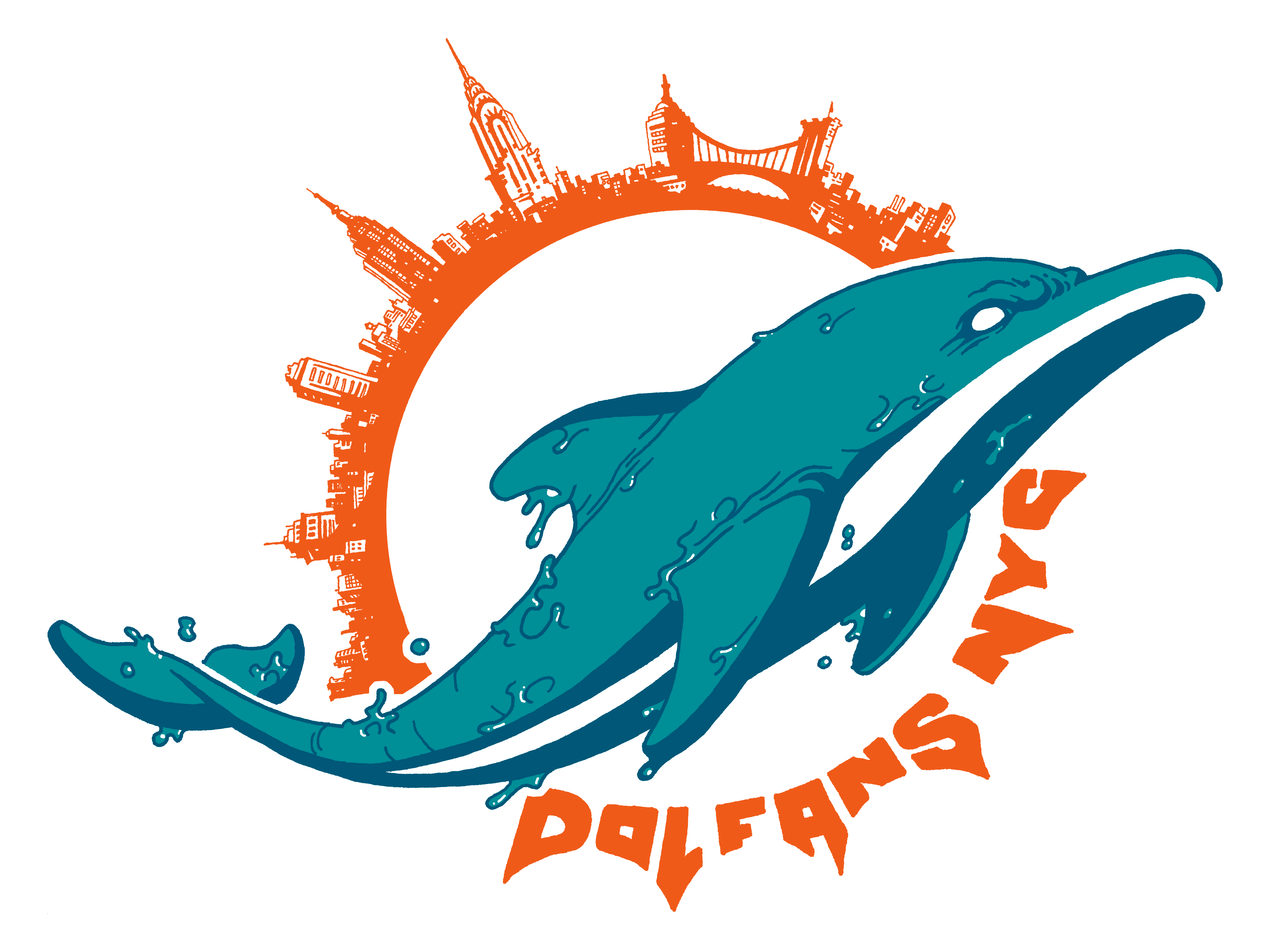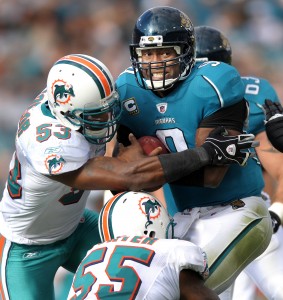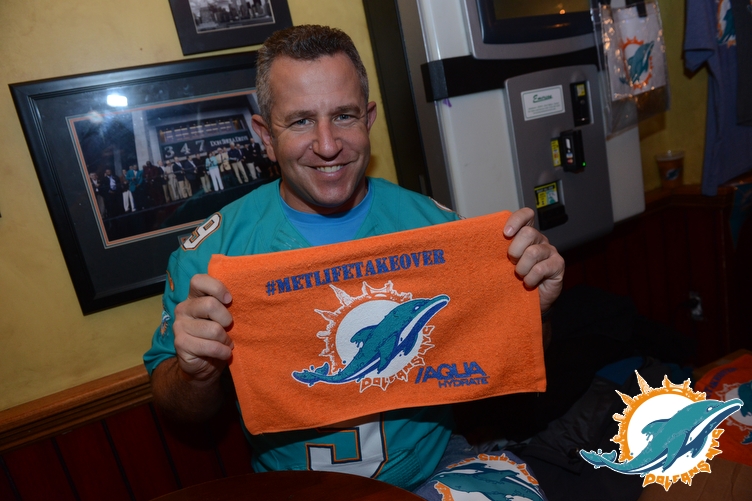
By the time Jay Fiedler hung up his cleats – six years after unenviably following in franchise icon Dan Marino’s massive footsteps – only Marino and Bob Griese had won more games, thrown for more yards or tossed as many touchdown passes in Dolphins history.
For an undrafted free agent who’d been cut by two NFL teams in the span of a month, served as a volunteer assistant coach at Hofstra University and suited up for the Amsterdam Admirals of NFL Europe – all before attempting his first official NFL pass with the Vikings in 1998 – seeing his name among the all-time greats remains especially humbling.
“To be in the company of those two Hall of Fame names – to have the longevity of being the starting quarterback for the Dolphins for five years – means a lot to me,” says Fiedler. “Certainly, the road that it took me to become a starting quarterback made it even sweeter. Every time you get a chance to overcome challenges and come out on top at the end, it’s a heck of a lot more rewarding than being given that job.”
Ironically, the lopsided score of Marino’s final NFL game presented an opportunity for the then-Jaguars second-stringer to showcase he was ready for a starting role – and as it turned out, No. 13’s eventual replacement.
“I didn’t realize it at the time, but I think it was definitely an audition for Miami,” recalls Fiedler, who completed 7 of 11 passes for a game-high 172 yards and two scores in a relief appearance on Jan. 15, 2000. “I think the thing that certainly helped me sign with Miami that following year was the fact that I not only came in that game and played well, but that I started the last regular-season game for Jacksonville. The Dolphins didn’t know who was going to start the game that week – we kind of kept it hush-hush whether (Mark) Brunell was going to come back or not – so it forced the Dolphins to scout me … and really opened up the eyes of the scouting department and the personnel.”
After helping guide the Dolphins to the AFC East division title in his first season in South Florida, the Dartmouth alum – who amassed a 36-23 record along with 11,040 passing yards and 66 touchdowns in aqua and orange – submitted his best year in 2001, notching 20 TDs (10th in the NFL), 3,290 passing yards (14th) and 7.3 yards per pass attempt (sixth) en route to leading Miami to a second consecutive 11-5 finish and playoff appearance.
In a recent phone interview, Fiedler reflected on his long road to NFL stardom, the challenges of succeeding Marino, Ryan Tannehill’s development and much more.
As a multi-sport athlete growing up, what ultimately led you to pursue a football career?
“I did every sport imaginable growing up. I remember when I was six or seven years old, I was into soccer, football, baseball, basketball, track and field – you name it. I did three sports in high school – football, basketball and track and field – and then football and track and field in college. Of course, being a multi-sport guy, I ended up doing the decathlon in track and field.
“I spent two years doing both at Dartmouth, and eventually, the idea of putting weight on for football and taking it off for track and field, (plus) the grueling non-stop competition, became too much. I’ve always loved football, I had some great success in Dartmouth my first couple of years, and I decided that was what I was going to keep pursuing.”
Which players did you admire growing up and model your own game after?
“My favorite quarterback growing up was probably John Elway. He was a guy who I tried to model my game after – just his versatility, his escapability out of situations. Although I couldn’t get up quite to his arm strength, I felt like I was able to do a lot of things out on the football field just like he was able to do.”
As an undrafted free agent, what were the keys to landing your first NFL contract with the Eagles?
“As an undrafted free agent, it was really just a matter of making the team. I had about four or five teams that offered me contracts right after the draft ended. I decided on going to Philadelphia because of two factors. One, Rich Kotite was the coach there, and he convinced me that he was going to give me a shot to really compete for the job and to make the team. And two, at the time they weren’t so set on their three quarterbacks. So, it looked like an opportunity for me to have a chance to make the team and to move my way up the depth chart as things went along.
”
After being cut twice and out of the NFL for nearly two years, what did it take to make it back to the pros?
“That was probably the most difficult time in my career. Getting cut by the Eagles, it was really a situation of coaching and ownership changes – they were just going in a new direction, where they were kind of cleaning house. By the time they actually cut me, it was already a couple of weeks into training camp, so even though I got picked up by Cincinnati, I only had a very short window to try and prove myself. I was actually the fifth (quarterback) on the roster out there, so it was an uphill battle.
“I found myself out of the game for the first time in my life. It was a frustrating time, but I also knew from playing for two years, seeing how guys practiced and seeing the games up close, that I was talented enough to make it. I didn’t let it discourage me and I didn’t give up on the game.”
How did you train and what did you focus on during that time?
“I decided to keep myself as close to the game as possible. I went home and became a volunteer coach at Hofstra University. I’d known a couple of the coaches over there, and they gave me an opportunity to use the weight room and work out with the team. I’d go out, throw to wide receivers and keep my arm loose. It helped me stay sharp and stay in the game.
“Then, I ended up going out to Europe for a season, and played in NFL Europe at Amsterdam. I was teammates with (current Chargers Head Coach) Mike McCoy at the time, and I saw all the way back then that he would be a coach. Even though I didn’t get an (NFL) opportunity again coming into (next) season, it kept me focused and kept my mind on the game.
“Finally, after another year of coaching at Hofstra, it took one last-ditch effort to get back into the league. I got together with my agent and my high school coach – who was a big mentor of mine throughout my career – and we came up with a game plan to put a package together, send it out to every single team and start calling up every quarterback coach, offensive coordinator and head coach. We got one response from Minnesota, and that’s all I needed. Chip Myers was the quarterback coach, and he gave me an opportunity to try out for the Vikings. I went out there, they signed me, and from that point forward, I just kept climbing the ranks until two years later, I was the starting quarterback in Miami.”
In addition to Chip Myers, which other coaches helped prepare you for a starting role?
“All the coaching I got was the biggest thing from playing on all those different teams. I played under Jon Gruden as a coordinator and quarterback coach in Philadelphia. In Minnesota, Brian Billick was the offensive coordinator. Down in Jacksonville, Tom Coughlin was the head coach and really ran the offense, and Bobby Petrino was the quarterback coach. I was able to pick the brains of each of them and mold their teaching to what I felt comfortable with and what I was able to do physically on the football field.”
How would you describe following in Marino’s footsteps as the Dolphins starter?
“I never looked it as a challenge to replace Marino.
I had success every time I played – from high school, college and during the times that I was able to get into games in the pros prior to that. I did it my way. I wasn’t going to come in there and do it the way Marino did it. There are a lot of ways to win games – that’s really the way that I looked at the position.
“Certainly, there were challenges just from an off-the-field standpoint – having to deal with media and fan scrutiny as the next guy after Marino – but I always felt like I had thick skin and never let outside distractions or influences change the way that I approached the game. In that respect, just from a mental and psychological standpoint, I was the perfect guy to come in and do that.” Continue reading “Q&A: Former Dolphins QB Jay Fiedler”
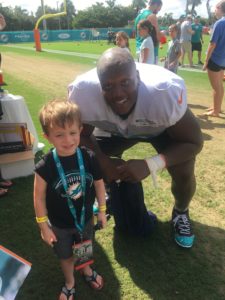 Charlie – a laminated media pass dangling from a lanyard around his neck down to his knees – joined a group of Dolphins fan website moderators for a team-organized Web Weekend Training Camp event last Sunday.
Charlie – a laminated media pass dangling from a lanyard around his neck down to his knees – joined a group of Dolphins fan website moderators for a team-organized Web Weekend Training Camp event last Sunday.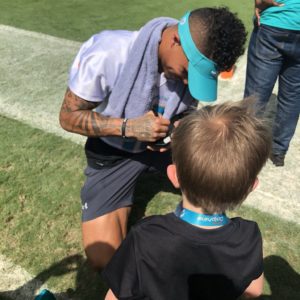 Before departing, we stopped to greet Kenny Stills, who’s renowned for staying long after every practice to sign and take pictures with fans, just as he did for us last season. True to form, the Dolphins wide receiver smiled and chatted with an animated Charlie, who collected his second lifetime autograph from No. 10 – except this time, on a miniature toy ukulele that rarely leaves his side.
Before departing, we stopped to greet Kenny Stills, who’s renowned for staying long after every practice to sign and take pictures with fans, just as he did for us last season. True to form, the Dolphins wide receiver smiled and chatted with an animated Charlie, who collected his second lifetime autograph from No. 10 – except this time, on a miniature toy ukulele that rarely leaves his side.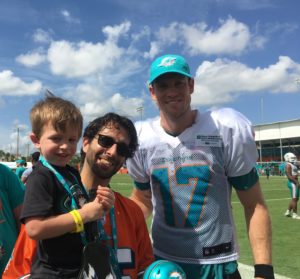 Fast forward to Sunday – nearly four years later – and Charlie finally had a chance to meet his favorite player in person. While he was too shy to ask the quarterback about his “boo-boo” – he’ll get his media chops soon enough – he did hand him that trusted ukulele. A surprised Tannehill laughed before graciously signing the slightly-peeling body of the musical instrument, and gave Charlie a resounding high five after learning the full backstory of his connection to the young fan.
Fast forward to Sunday – nearly four years later – and Charlie finally had a chance to meet his favorite player in person. While he was too shy to ask the quarterback about his “boo-boo” – he’ll get his media chops soon enough – he did hand him that trusted ukulele. A surprised Tannehill laughed before graciously signing the slightly-peeling body of the musical instrument, and gave Charlie a resounding high five after learning the full backstory of his connection to the young fan.
